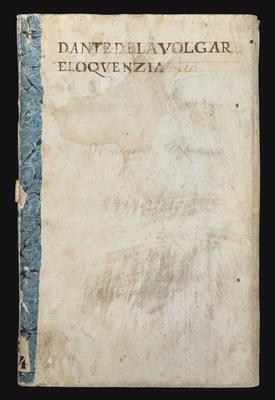Dante Alighieri
Dante. De la Vωlgare Elωquenzia...
Vicenza, Tolomeo Gianicolo, January 1529.(Bound with:) Gian Giorgio Trissino, Dialogω del Trissinω intitulatω il Castellanω, nel quale si tratta della lingua italiana... [Vicenza, Tolomeo Gianicolo, 1529]. Id., Epistola del Trissino de le lettere nuωvamente aggiunte ne la lingua italiana... Vicenza, Tolomeo Gianicolo, February 1529.
Three works in one volume, large 4° and small folio (286x182 mm). I. Collation: a-b8, c6, d4. [26] leaves. II. Collation: A-B8, C4. [20] leaves. III. Collation: A4, aa-bb4, cc6. [17], [1] leaves. Woodcut printer's device on each title-page. Italic and Greek type. Contemporary limp vellum. Smooth spine later covered with marbled paper, with title in dark ink on orange paper label; at the foot of the spine the early shelfmark ‘K 274' on a small paper label. On the front cover the title ‘dante de la volgar eloqvenzia' and the name of Trissino in cursive script, both inked in an early hand. The title in capital letters also inked on the lower and upper edges. Binding partly detached, remains of the original leather bands. A fine copy. Numerous annotations and reading marks in Brevio's own hand.
Provenance: Giovanni Brevio (d. 1549 ca.; ownership inscription ‘Del Brevio et amici' on the front turn-ins); Livio Ambrogio collection.
The copy – a remarkable discovery – owned and assiduously annotated by the Venetian scholar and poet Giovanni Brevio of the first edition of Trissino's Italian translation of De vulgari eloquentia, the unfinished treatise which the exiled Dante wrote between 1304 and 1307 in Latin. The subject of the work is the nature of poetry in vernacular languages – above all Italian – and it attempts to defend, against their detractors, the eloquence of the vernacular languages, which in Dante's opinion potentially deserved the same dignity as Latin. Trissino edited the De la Volgare Eloquenzia – the original Latin text appeared only in 1577 – on the basis of a manuscript in his possession, today in the Biblioteca Trivulziana in Milan (ms1088).
In addition to the Italian translation of the De vulgari eloquentia the miscellaneous volume presented here also includes – as frequently found – two treatises composed by Trissino himself: the first edition of the Dialogo intitulato il Castellano and the reprint of the Epistola de le lettere nuovamente aggiunte ne la lingua italiana (first published in 1524), both printed like the Dante work in 1529 by the enigmatic Vicenza printer Tolomeo Gianicolo, and set in the handsome italic type, with the addition of the Greek vocalseand w, designed for him by Ludovico degli Arrighi.
Of the just four books which are known to have belonged to Giovanni Brevio – a close friend of Pietro Bembo, Giovanni Della Casa, Francesco Berni and Pietro Aretino – the only one hitherto identified with an actual physical copy is the Aldine Petrarch of 1514. The copy is today in the Biblioteca Nazionale in Florence, and displays the same ownership inscription, ‘Del Brevio et amici' found here. In this newly discovered volume Brevio has marked several words and phrases in the margins of the text of the De la Volgare Eloquenzia. There are autograph annotations also on the leaves which contain Trissino's Castellano, and there is an important and lengthy note in the margin of fol. B8r, in which Brevio refers to two passages from the Convivio on the Italian vernacular. This copy therefore gives a unique insight into Brevio's careful reading of Dante, and at the same time reveals the lasting influence of Dante's reflections on poetic and literary language, especially on the use of the vernacular, in the Italian Renaissance.


